|
The Nellis UFO Video: |
"IT'S WEIRD-LOOKING!"
A STUDY OF THE 1994 NELLIS UFO VIDEO FOOTAGE
PART TWO
by Martin J. Powell
Ever since having first seen the Nellis UFO footage, I have believed that it should be possible to construct a model of the object, based on the large amount of visual information available. Unlike UFO photographs, where usually only one viewpoint is available, the Nellis footage has the advantage of showing the UFO from a wide range of angles in an almost continuous transition. Indeed, most parts of the object can be seen at some stage in the footage, the only real exceptions being a clear view of the top and rear.
Object Components
Numerous researchers have commented that the object changes its shape from frame to frame, even appearing as a "fuzzy, gassy cloud" at one point.1 This would clearly be difficult to replicate in what I had hoped would be a solid and permanent model. Clearly, before construction of a model could be attempted, the veracity of these claims needed to be tested by way of a detailed, frame by frame examination of the footage.
After having studied the footage many dozens of times, I have produced a model which accounts reasonably well for the appearance of the UFO over the majority of the footage running time. I cannot claim that the model is a truly accurate representation of the Nellis object, but I believe it is at least a good approximation to its appearance.
For the sake of clarity in the account which follows, I will detail the object's component parts as far as I have been able to determine. The names I have given them are based solely on their appearance, and they are not intended to reflect their likely function.
Many commentators have already established that the object comprises three or four 'bumps' or 'spheres' and a dark appendage, often described as being 'in the centre'. A proposed plan, profile and section of the object is shown in Figure 1 (34 KB). There are three lobes, a dark coloured frontal unit and a tail unit. The lobes comprise a dorsal lobe and two side lobes (port and starboard). Two small projections extend from below the inboard trailing edges of the side lobes. Other small projections also appear which I will later describe where appropriate.
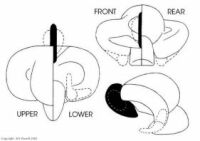 Figure
1 A
proposed plan, profile and section of the Nellis UFO, drawn from
the author's model (click for full-size image, 34 KB). The side lobe projections are shown in the forward
position.
Figure
1 A
proposed plan, profile and section of the Nellis UFO, drawn from
the author's model (click for full-size image, 34 KB). The side lobe projections are shown in the forward
position.
There is only one known reference to the object's colour, given by "Frank", who was apparently a witness to the event. He says the object changed colour, but gives no specifics.2 In the absence of such details, the model has been coloured black and white, reflecting its appearance in the monochrome footage.
I will now give a detailed description of the object's appearance and behaviour throughout the S-30 clip, which runs for approximately 2 minutes and 38 seconds. In the process I will draw attention to the object's various recognisable components, what function they might serve and how they are represented in the model. All times in the footage are in UTC, which is equivalent to GMT.
Object Appearance and Behaviour
At the start of the footage the object appears as an indistinct, dark blob moving relatively slowly in front of the distant mountain range (see Part 1).
As it approaches, it performs a couple of bizarre sideways movements, as if it were adjusting its flight path in order to head towards the tracking station. The apparent size of the object increases notably after the second period of sideways flight, and it climbs at a much higher rate. The camera operator attempts to zoom in on the object at 23:21:39 but it climbs too rapidly to stay within view and he stops zooming and pitches the camera upwards. The object's lobed structure becomes evident at 23:21:43 when it rises up in front of a darker cloud layer and the camera exposure compensates for the darker image.
|
|
The camera zooms in on the object at 23:21:51 (Figure 2 upper, 20 KB), but at 23:21:56 a dramatic transformation takes place. As it rises toward the upper right corner of the screen, it appears to 'inflate' from below, from inside to outside, so that by the end of the transformation the object appears very different to what it had been only a second previously. The tail unit is reduced to nothing more than a small 'dot' at the base of the image, confusing the visual perception of the object. Two large lobes appear to have developed at its base, so that the rear momentarily appears larger than the front. Comparison of still frames before and after the expansion suggests that the object changes its aspect during this period, however this does not in itself necessarily explain the apparent shape change. It is possible that the side lobe trailing edges expand substantially during these couple of seconds; if so, the model suggests at least a doubling of their size. The trailing edge expansion may affect the object's rate of climb or it may affect its speed. The frontal unit appears only as a vague dark region throughout this period. The side lobes have deflated by 23:22:04, and after this the main features of the object become clearer. In particular, the side lobe projections can gradually be discerned as the object approaches.
Sunlight interferes with the image clarity from about 23:22:07, and the object is essentially invisible by 23:22:10. When it re-emerges around 23:22:16 the frontal unit appears to have enlarged, although this is probably due to the camera compensating for changes in the light, rather than a physical expansion of the unit. This camera effect is seen again at 23:22:22, when the object suddenly appears to take on its full shape.
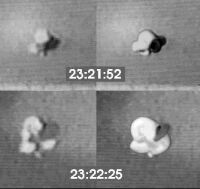 Figure
2 (Click
for full-size image, 20 KB). In
this and the Figures which follow, the original Nellis UFO image
is shown on the left and the author's model on the right. Times
are shown in UTC in each case.
Figure
2 (Click
for full-size image, 20 KB). In
this and the Figures which follow, the original Nellis UFO image
is shown on the left and the author's model on the right. Times
are shown in UTC in each case.
Beyond this point we have our first detailed look at the underside of the object (Figure 2 lower, 20 KB). The side lobes are seen to involve semicircular structures which line their perimeters, and the two projections are seen to originate from the trailing edges. The port projection looks to be deployed at a lower angle than that on the starboard side. The front and tail units are now much clearer and their relationship to the rest of the body can be discerned.
The period between 23:22:17 and 23:22:42 may provide an indication of the manner in which the object moves through the air. Although exacerbated by camera motion, the object appears to 'leap' several times during this period, emulating the movement of a frog. Significant jumps occur at 23:22:17, 23:22:23, 23:22:28, 23:22:33, 23:22:35 and 23:22:42. The average interval of five seconds between jumps suggests that this may be a genuine behavioural characteristic of the object.
When the object re-appears at 23:22:39 after leaping out of shot, the camera holds the object steady for a few seconds. We then have a revealing view of the object from the starboard side - it rather looks like a human foetus (Figure 3, 20 KB). The port projection is angled downwards at about 45º, behind the tail unit. It appears wider at the top than the bottom, and it bends slightly about half way along its length. Within a second or so the projection has changed its appearance slightly, suggesting that it may be capable of flexing up and down. Another rounded extension can be seen facing forward about half way up the object's body. This is probably the starboard lobe projection in a forward facing position. If this is a correct identification - as the model seems to suggest - then it implies that the port and starboard projections are capable of moving forward and downward, independently of each other.
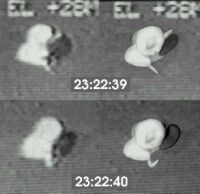 Figure
3 Two
side views of the UFO, showing the three projections (click for
full-size image, 20 KB). The uppermost
projection recedes into the UFO's body and a second later it is
no longer visible.
Figure
3 Two
side views of the UFO, showing the three projections (click for
full-size image, 20 KB). The uppermost
projection recedes into the UFO's body and a second later it is
no longer visible.
Another prominent feature across these few seconds is a projection extending forwards from the upper region of the object. It is inclined upwards at about 45º and almost appears to 'rest' on top of the frontal unit. There seems to be no equivalent feature visible in this region of the object in the earlier frames. The projection rapidly recedes into the object's body in the second after 23:22:39, until it is no longer visible. The model suggests that this projection is situated on the leading edge of the starboard lobe. Evidently this feature is capable of rapid transformation and, like the side lobe projections, appears to be constructed from a highly flexible material.
At 23:22:41, the object suddenly turns clockwise to face the tracking camera. It appears to 'leap' upwards in order to achieve the turn. The change in its appearance from side to front view is dramatic, the situation being made more difficult by its disappearance out of shot for a fraction of a second, and also the fuzziness of the image.
As the object re-appears at the top of the screen at 23:22:43, it is facing forward (Figure 4 upper, 24 KB). The frontal unit now appears very small in comparison to the dorsal and side lobes, contradicting the impression gained about its large size earlier in the footage. The answer seems to lie in the fact that the frontal unit has a narrow width, and also because the object has pitched downwards by about 45º during the turn. Because of the tapering shape of the frontal unit, less of the dark lobe is visible when the object is pitched downward.
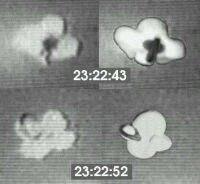 Figure
4 (Upper)
The UFO turns to face the camera, then (Lower) 'shields'
cover the frontal unit and the UFO begins the "surveillance
period" (click for full-size image, 24 KB).
Figure
4 (Upper)
The UFO turns to face the camera, then (Lower) 'shields'
cover the frontal unit and the UFO begins the "surveillance
period" (click for full-size image, 24 KB).
The sequence of events during the nine seconds after 23:22:43 is complicated. The object drops downward after 23:22:43 (this may only be due to camera motion) whilst pitching slightly nose down. As it descends, it continues rotating clockwise and starts pitching upwards. During this phase, the narrow width of the frontal unit can be seen. The object reaches the top of the screen at 23:22:45, moving partly out of shot for a fraction of a second, before it 'drops' again whilst continuing its clockwise rotation.
For the two seconds after 23:22:45 the frontal unit undergoes a major transformation which is difficult to follow because of its rapid motion and the increasingly poor contrast. What is clear is that by 23:22:47 the frontal unit has been largely covered on each side by a dome-shaped 'shield'. This may not be a correct interpretation, but for the purposes of the model it seems to provide at least a partial explanation. The starboard shield appears to emerge from the leading edge of the starboard lobe, forming a prominent bulge at the front of the object over the next second. The bulge appears in the approximate location of the upper projection seen in the side view at 23:22:39. Its ability to appear almost instantaneously - demonstrated in the earlier footage - lends support to the notion that this is the source of the shields. It is unclear from the footage whether an equivalent projection emerges from the object's port side, to form a port shield. Some evidence for this appears at 23:22:45, when a slight bulge at the leading edge of the port lobe might indicate a similar projection. The object continues to rotate clockwise until 23:22:46, when it suddenly moves upwards, tilting slightly to starboard and revealing its underside. The shields seem to 'lock' firmly into position about a second later.
|
|
By 23:22:48 the object is seen from below and ahead of the port side leading edge. The model suggests that it is also pitched slightly nose down. The visual perception of the object is confused from 23:22:48 to 23:22:55 because of the image brightness, which causes the perspective of the lobes to vanish. The dorsal and port lobes, seen from a lower viewpoint, appear to merge into one (Figure 4 lower, 24 KB). They are only seen to separate when the object begins a slow anti-clockwise rotation at 23:22:56. The placement of the various lobes relative to each other can be discerned with care over the next few seconds.
As the object rotates between 23:22:54 and 23:22:57, a projection can be seen extending downwards from the inboard trailing edge of the starboard lobe (Figure 5 upper, 27 KB). The model indicates that this is the starboard lobe projection in a 'half down' position. No similar feature appears on the port side as the object rotates past the point where it should be visible. Hence, the side lobe projections must be extended asymmetrically at this point - but in the opposite manner to that when seen from the side at 23:22:39. Interestingly, in the side view the port projection is deployed in the downward position just before a clockwise rotation, whilst at 23:22:54 the starboard projection is downward during an anti-clockwise rotation. This might indicate that the projections play a role in the object's directional (yawing) control.
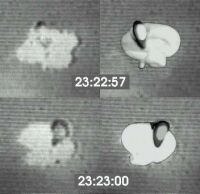 Figure
5 (Upper)
As the UFO rotates, the starboard lobe projection can briefly be
seen (click for full-size image, 27 KB) (Lower) The frontal unit
rotates to its fullest extent,
so that the 'shield' is facing fully forward.
Figure
5 (Upper)
As the UFO rotates, the starboard lobe projection can briefly be
seen (click for full-size image, 27 KB) (Lower) The frontal unit
rotates to its fullest extent,
so that the 'shield' is facing fully forward.
The object now begins what might be called the 'surveillance period'. As it rotates anti-clockwise, the frontal unit moves clockwise, i.e. in the opposite sense. By the time the object stops rotating at 23:23:01, the shielded frontal unit has rotated to its fullest extent, so that the port shield is facing directly forward (Figure 5 lower, 27 KB). The model has been modified so that the frontal unit is able to rotate within a cavity set inside the front section of the dorsal lobe. This is a speculative modification and the existence of such a cavity cannot be determined from the footage evidence. Shady and possibly cavity-like regions can be discerned at 23:21:52, 23:22:43 and 23:22:45.
After a brief pause the object then begins to rotate clockwise for two seconds after 23:23:04. As before, the frontal unit slowly rotates in the opposite sense, i.e. anti-clockwise. The unit does not rotate to its fullest extent on this occasion but reaches a position several degrees away from it. The object then regains anti-clockwise rotation from 23:23:07 through to the end of the footage.
Again, the frontal unit rotates in the opposite sense to the body and reaches a position where the port side shield is in the fully forward position. At 23:23:14 the port shield can be seen in profile as a dome-shaped feature at the front of the object. The contra-rotations of the shielded frontal unit and the main body of the object suggest a functional relationship between them, possibly a 'surveillance' technique.
 Figure
6 The
UFO continues to rotate anti-clockwise as the S-30 footage comes
to an end (click for full-size image, 13 KB).
Figure
6 The
UFO continues to rotate anti-clockwise as the S-30 footage comes
to an end (click for full-size image, 13 KB).
The object continues to rotate several degrees beyond the starboard side view position by the end of the footage at 23:23:17 (Figure 6, 13 KB). The model suggests that, in the final seconds, the port projection is not deployed in the downward position, re-enforcing the impression gained some twenty seconds earlier. It is not clear whether the starboard projection is still downward at this point, because its visibility is washed out by the brightness of the object's underside - a particularly marked problem in the closing seconds.
Summary
Although much has been said about the object's changing shape throughout the footage, the model, together with careful frame by frame analysis, suggests that this is partly a misperception. Abrupt changes in the camera exposure often give the misleading impression of a shape change. In addition, poor image contrast causes the depth perspective to be lost on many occasions, as the various features of the object appear to merge into one. I hope that by illustrating the model alongside the original Nellis UFO image I have demonstrated how such misperceptions could have come about.
The lack of shape change can be shown by comparing the UFO images from widely differing periods of the footage. For example, frames 23:21:47 and 23:22:43 show the object from the front and pitched nose-down. Although set well apart in time, the shape of the object is essentially identical in both cases. Frames 23:22:27 and 23:23:00 show the object from below and from the forward-starboard position. It appears the same apart from the shield covering the frontal unit in the later image. Frames 23:22:03 and 23:22:25 show that the object looks essentially the same both before and after its disappearance into the sunlight, but camera contrast has masked much of the detail in the earlier scenes. In the side views at 23:22:40 and 23:23:14, the rear of the object appears similar, but the frontal region appears notably different. This is because the later scene shows it from a steeper angle (39º elevation as opposed to 28º in the earlier scene).
Although the UFO is lit from behind for much of the time, the shadow on its surface is not easy to reconcile with a back-lit object. Perhaps the object is self-illuminating, but whatever the case may be, the camera's exposure setting renders the object too bright for much of the time. The camera adjusts abruptly to subtle background light variations, no doubt adding to the object's confusing appearance.
There is however little doubt that certain parts of the object are capable of size and shape changes, particularly the side and frontal projections. The airframe appears somewhat flexible - far removed from conventional, rigid components. The dorsal lobe shows the least change throughout the footage and this might contain the propellant, or possibly a gas which keeps the object aloft. The tail unit is the least visible element and this might contain the propulsion system. Directional stability is probably provided by onboard avionics, the tail unit and, to a certain extent, by the side lobe projections. The semicircular structures beneath the side lobes might circulate a flow of gas, perhaps to the side projections or to/from the tail unit. This is perhaps as much as can be said about the object's components, on the basis of the footage evidence.
|
|
REFERENCES
1. Susan Michaels, 'Invader on the Range', in Sightings: UFOs, Simon & Schuster, New York (1997), pg. 125.
2. Ibid., pg. 123.
|
The Nellis UFO Video: |
 Trindade
Island UFO Photos (1958)
Trindade
Island UFO Photos (1958)
Copyright Martin J Powell 2002
Site hosted by TSOHost |